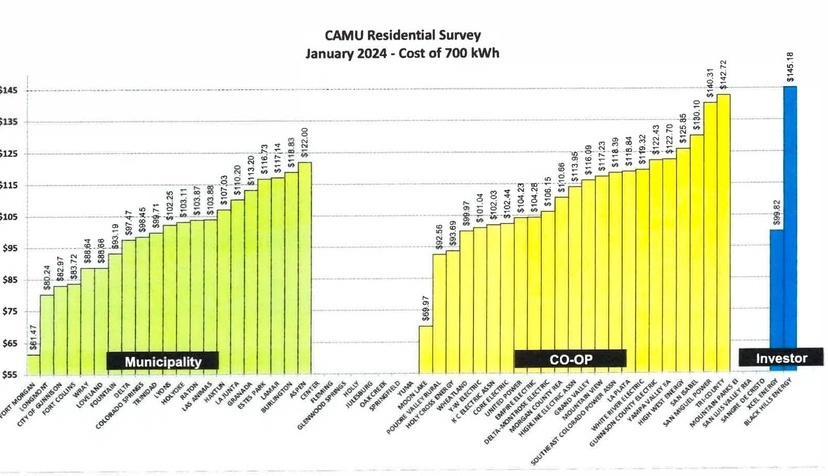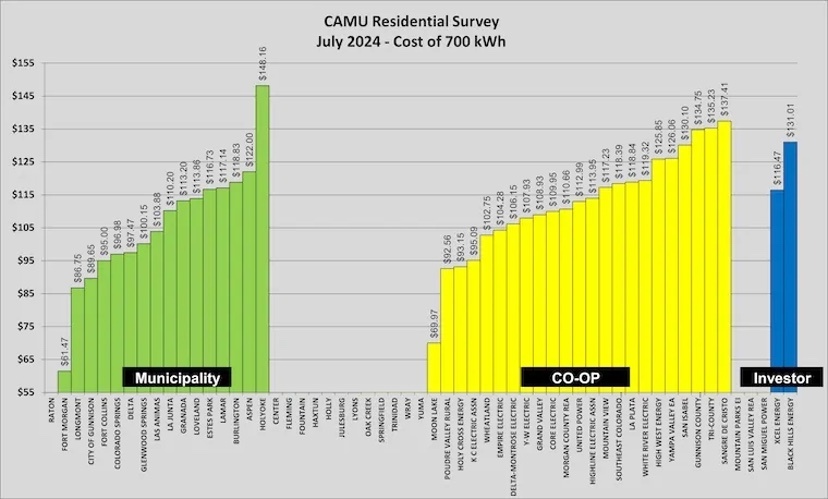This story appeared on BigPivots.com on November 1, 2024
This chart, below, tells part of the story of Black Hills, an investor-owned utility that has 100,000 customers stretching from Cripple Creek to Rocky Ford, including Cañon City and Pueblo along the way.
Black Hills had Colorado’s most expensive electricity, according to a January survey of 21 municipalities, 23 electrical cooperatives, and the state’s two investor-owned utilities: Xcel Energy and Black Hills. Eleven utilities did not respond to the survey by the Colorado Association of Municipal Utilities. The CAMU chart was filed at the Public Utilities Commission in opposition to a rate increase sought by Black Hills

But wait – there’s an update. After this story was first posted on November 1, Black Hills submitted a more recent CAMU survey, this one conducted in July. It shows that the rates of Black Hills are surpassed by several other utilities. We’ll get to that more recent CAMU survey later in this story. Also, on Nov. 8, Black Hills announced it was paring its requested increase by 33%.
Incomes that sag below state averages are also part of the story, and Black Hills acknowledges this.
“The median household income in (Black Hills) service territory is 37% lower than the Colorado median (Pueblo and Canon City incomes are less than $60,000 per year and Rocky Ford incomes are less than $32,000 per year),” testified Floyd Wolf, the general manager for Black Hills operations in Colorado, in a June filing.
Black Hills, he said, has programs intended to address the needs of those communities identified as disproportionately impacted. The filing was intended to support the Black Hills case for a rate hike.
The most immediate question is whether the Colorado Public Utilities Commission will approve the rate hike proposed by Black Hills or do something they have rarely done before: refuse to approve any rate increase.
Cindy Schonhaut, the director of the state’s Office of the Utility Consumer Advocate, which was created by state legislators to look after the interests of residential, small business, and agriculture users in rate and other cases before the PUC, filed testimony on Oct. 11 that calls on the PUC commissioners to say no. It has rarely made that request in rate cases involving electric, gas, and other regulated utilities.
“The state is at an inflection point in the development of new priorities regarding affordability of rates for utility customers,” Schonhaut wrote in her testimony.
“When those points coincide, a different approach is necessary. Now is the time. In this case, denying the proposed rate increase is the only option available to the Commission that will begin to address the unaffordability of electric bills for (Black Hills) customers.”
Pueblo Mayor Heather Graham was even more direct in her testimony than Schonhaut. In an October 11 filing, she said that “Pueblo has a high rate of poverty and, at the same time, the highest electric rates in the state. Our residents do not understand how this has come to be accepted and why the Public Utilities Commission has allowed this to occur,” she wrote.
Graham called Black Hills a “predatory company that acts like a colonial occupying army, extracting whatever they can from our community, ignoring the pain they cause when people have to choose between medical care or keeping their lights on or their air conditioner on.”
Part of the conversation includes to what extent high energy costs have discouraged economic development in the Pueblo-Cañon City areas.
The area has some of the cheapest real estate along the Front Range, and Pueblo has excellent water supplies. Pueblo has other issues of poverty and crime, however, that contribute to companies choosing to look elsewhere.
How does Black Hills justify the proposed rate increase? Michael Harrington, in a June filing, said that Black Hills has not sought a change to its base rate of service in eight years. It has invested over $370 million in strategic capital projects from 2016 through 2023 and, at the time of the filing, planned to invest $98.5 million in 2024 in capital projects.
Harrington also reported “recent macroeconomic inflationary factors” that have increased the costs of Black Hills. The proposal represents an increase of 2.25% per year when averaged over the last eight years for the average residential customer, he wrote.
The company also argues that it is at a disadvantage in offering and implementing demand-side management measures on a cost-effective basis because of the demographics and economics of its service territory, which pose “unique challenges.”
Black Hills also wants an adjustment of policies governing net-metering that benefit customers with rooftop and other solar resources that they own. The number of residential net-metered customers has grown from 605 in 2016 to 7,739 at the end of 2023, which allows customers with solar to benefit.
The larger question posed by the Black Hills rate case is whether it will reignite efforts in Pueblo or other jurisdictions to find alternatives. One possible path would be municipalization. In other words, would Pueblo create its own municipal utility such as exist in several dozen other towns and cities in Colorado? In one case, that of Colorado Springs, the city utility has its own generating capacity. Other municipal utilities contract with other suppliers.
The proposal before Pueblo voters in 2020 to authorize municipalization was defeated by a three-to-one margin. Proponents estimate that their modest advertising budget was dwarfed by the $1.5 million to $2 million that they estimated was spent in efforts to defeat the measure.
The Pueblo Economic Development Corporation, which sat on the sidelines of that vote in 2020, has joined local governments in filing testimony in opposition. The city council in 2020 was divided on municipalization. One issue was the cost. The assets owned by Black Hills are valued at possibly $1 billion.
Might the vote this time turn out differently?
“That’s the billion dollar question,” said Pueblo City Council President Mark Aliff in a July interview. “I think the community at this point is very, very fed up with Black Hills Energy. But are they willing to invest a billion dollars to get rid of them? I don’t know.”
Cañon City’s franchise agreement with Black Hills expired in 2017 and the city has not renewed it. A municipal advisory committee studied the city’s options, such as contracting for services with an electrical cooperative or other power provider, but came up with no plan. Undergirding that conclusion was the realization that getting a divorce from Black Hills would likely be expensive.
“We knew that Black Hills would not be a willing seller and would do all they could to hang onto their assets and their cash cow that south-central Colorado has become for them,” says Emily Tracy, a city council member who was a member of the committee. And Cañon City, she emphasized, does not have great wealth for a protracted legal battle, if it came to that.
About the same time as Pueblo was considering municipalization, Boulder voted whether to get a divorce from Xcel Energy. There, city voters also ended up rejecting municipalization. However, Boulder’s franchise agreement has a potential exit ramp coming up.
Tracy uses “impasse” and “dilemma” when talking about the situation of Cañon City and the Black Hills rate case altogether.
She reports a “few conversations” with state legislators and others about the idea of having some kind of pilot project in the Black Hills service territory. It’s the perfect place to try something different.
One concept is called community choice energy. The idea has percolated for several years in Colorado, but a report commissioned by the state government found inconclusive benefits to the concept. It worked in some places, but not in others.
Despite shopping this idea with legislators, reports Tracy, so far there are no takers. “We don’t have a champion for those ideas that will take time to get moving.
“My assumption is that legislators and probably the governor’s office just don’t want to take on this political battle with these two IOUs (investor-owned utilities),” says Tracy.
As for that CAMU survey, Black Hills pointed out that the July numbers looked somewhat different from those in January.

“A close look at the CAMU data over time shows a narrowing gap between average residential customer bills from Black Hills Energy and other utilities,” wrote Julie Rodriguez, senior public affairs manager for Black Hills, in an e-mail to Big Pivots.
“We believe this trend will continue – other utilities’ bills (are) going up – as electric service providers reckon the cost of the energy transformation and are preparing to shut down coal plants and likely will replace them with cleaner but more costly alternatives. The energy landscape is changing, impacting costs for all utilities and their customers.
“Demand on the grid is growing fast, thanks to data centers, building electrification and EVs, so utilities across the nation are investing more. This is not just a Black Hills Energy issue.”
Allen Best publishes the e-journal Big Pivots, which chronicles the energy transition in Colorado and beyond.

